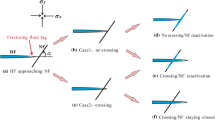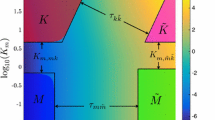Abstract
This paper examines the effective fracture toughness approach which is used in hydraulic fracturing in order to explain the high net-pressures that are often observed in field operations. The effective fracture toughness is calculated using a fully deterministic elasto-plastic hydraulic fracturing model. Rock is modelled by Mohr–Coulomb flow theory of plasticity for cohesive-frictional dilatant material. Fluid flow is modelled by lubrication theory. A cohesive crack model which takes into account the softening behaviour of rocks is employed as the propagation criterion. The fully coupled model is solved numerically by the finite element method and the effective fracture toughness is calculated using the path independent J-integral. The results show that plastic yielding near the tip of a propagating fracture provides an effective shielding, resulting in an increase in the rock effective fracture toughness by more than an order of magnitude. It is demonstrated that an elastic model based on the concept of effective fracture toughness matches the results of plasticity quite well. The effective fracture toughness increases with formation yielding, which is influenced by the deviator of the in-situ stresses, the rock strength, the elastic modulus and the pumping parameters. Tables of effective fracture toughness for a representative set of physical parameters are presented.
Similar content being viewed by others
References
Anagnostou, G. and Kovari, K. (1993). Significant parameters in elastoplastic analysis of underground openings. Journal of Geotechnology Engineering ASCE 119(3), 401–419.
Barenblatt, G.I. (1962). Mathematical theory of equilibrium cracks in brittle fracture. Advances in Applied Mechanics 7, 55–129.
Barr, D.T. (1991). Leading-Edge Analysis for Correct Simulation of Interface Separation and Hydraulic Fracturing. Ph.D. thesis, MIT.
Bazant, Z.P. (1986). Mechanics of distributed cracking. Applied Mechanics Review 39(5), 675–705.
Carbonell, R. and Detournay, E. (1998). Self-similar solution of a fluid-driven fracture. Proceedings of the Royal Society of London A (submitted).
Cleary, M.P., Wright, C.A. and Wright, T.B. (1991). Experimental and modeling evidence for major changes in hydraulic fracturing design and field procedures. Proceedings SPE Gas Technology Symposium, Houston, 131–146.
Desroches, J., Detournay, E., Lenoach, B., Papanastasiou, P., Pearson, J.R.A, Thiercelin, M. and Cheng, A.H.-D. (1994). The crack tip region in hydraulic fracturing. Proceedings of the Royal Society of London A 447, 39–48.
Detournay, E. (1998). Fluid and solid singularities at the tip of a fluid-driven fracture. Proceedings IUTAM Symposium on Non-Linear Singularities in Deformation and Flow (Edited by D. Durban and J.R.A. Pearson), Dordrecht, Kluwer Academic Publishers.
Detournay, E. and Cheng, A.H.-D. (1991). Plane strain analysis of a stationary hydraulic fracture in a poroelastic medium. International Journal of Solids and Structures 37, 1645–1662.
Gardner, D.C. (1992). High fracturing pressures for shales and which tip effects may be responsible. Proceedings of the 67th Annual Technology Conference and Exhibition of the SPE, Washington DC, 879–893.
Geertsma, J. and DeKlerk, F. (1969). A rapit method of predicting width and extend of hydraulic induced fractures. JPT 21(12), 1571–1581.
Hillerborg, A., Modeer, M. and Petersson, P.E. (1976). Analysis of crack formation and crack growth in concrete by means of fracture mechanics and finite elements. Cement and Concrete Research 6, 773–782.
Holder, J., Morita, N., Kenrick, A.J., Thallak, S.G. and Gray, K.E. (1993). Measurements of effective fracture toughness values for hydraulic fracture. SPE Production Operations Symposium, Oklahoma C., SPE 25491.
Kanninen, M.F. and Popelar, C.H. (1985). Advanced fracture mechanics, Oxford University Press, 386.
Kristianovitch, S.A. and Zheltov, Y.P. (1955). Formation of vertical fractures by means of highly viscous fluid. Proceedings of the 4th World Petroleum Congress 2, 579.
Labuz, J.F., Shah, S.P. and Dowding, C.H. (1985). Experimental analysis of crack propagation in granite. International Journal of Rock Mechanics and Mining Sciences and Geomechanics Abstracts 22(2), 85–98.
Papanastasiou, P. and Thiercelin, M. (1993). Influence of inelastic rock behaviour in hydraulic fracturing. International Journal of Rock Mechanics and Mining Sciences and Geomechanics Abstracts 30(7), 1241–1247.
Papanastasiou, P. (1997a). The influence of plasticity in hydraulic fracturing. International Journal of Fracture 84, 61–97.
Papanastasiou, P. (1997b). A coupled elastoplastic hydraulic fracturing model. International Journal of Rock Mechanics and Mining Sciences 34(3–4), paper No. 240.
Rice, J.R. (1968). A path-independent integral and the approximate analysis of strain concentration by notches and cracks. Journal of Applied Mechanics Transition ASME 35, 379–386.
Shlyapobersky, J. (1985). Energy analysis of hydraulic fracturing. Proceedings of the 26th US Symposium on Rock Mechanics, Rapid City, 539–546.
Spence, D.A. and Turcotte, D.L. (1985). Magma-driven propagation of cracks. Journal of Geophysics Research 90, 575–580.
Valco, P. and Economides, M.J. (1994). Propagation of hydraulically induced fractures — a continuum damage mechanics approach. International Journal of Rock Mechanics and Mining Sciences and Geomechanics Abstracts 31(3), 221–229.
Van Dam, D.B., de Pater, C.J. and Romijn, R. (1997). Experimental study of the impact of plastic rock deformation on hydraulic fracture geometry. International Journal of Rock Mechanics and Mining Sciences 34(3–4), paper No. 318.
Author information
Authors and Affiliations
Rights and permissions
About this article
Cite this article
Papanastasiou, P. The Effective Fracture Toughness in Hydraulic Fracturing. International Journal of Fracture 96, 127–147 (1999). https://doi.org/10.1023/A:1018676212444
Issue Date:
DOI: https://doi.org/10.1023/A:1018676212444




